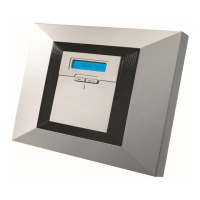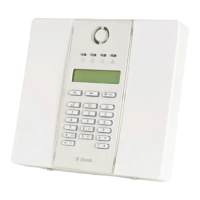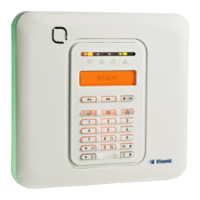14 DE5467U
Command Key
Listen-in (listening to the person at home) (*) [3]
Speak-out (speaking to the person at home) (*) [1]
Full-duplex (listening & speaking) (*) [6]
Note: To prolong the communication session by 50
seconds, press [3], [1] or [6] again, as required.
* The 2-way communication can be terminated by anyone
close to the PowerMax+, by disarming the system.
Remark Regarding Listen-in & Speak-out modes
Listen-in & Speak-out modes allow one way speech at a
time. Back and forth exchange of uninterrupted speech
between two parties is a method normally used in military,
commercial and amateur radio communication. Once you
finish talking you should say “Go Ahead” or “Over” and then
switch from speak-out to listen in. When the person at
home finishes talking he should also say “Over”, as a cue to
you to switch back from Listen-in to speak out.
EXAMPLE:
You (at remote telephone):
[1], “Hey, George, can
you hear me? Are you in any trouble? Over”....
[3]
Person at home: “Yes, I am. I had a dizzy spell while
trying to get out of bed and fell on the floor. I am unable to
get up and my thigh hurts. Can you help me? Over”...
You (at remote telephone):
[1], “Sure, I will send
someone right away, stay put - over”.....
[3].
Person at home: “Thanks, please hurry, over”.
You (at remote telephone):
[1], “All right, over and
out”.....
[]
9]
[9] (END OF SESSION)
Important! If you wish to exit the two-way communication
mode and execute another command, just press [
] and
then key your user code followed by the command (see
“keying sequences” in Para. 6.3 B above).
6.4 Reporting to Private Telephone
PowerMax+
control
panel
The PowerMax+ can be programmed by the installer for
selective transmission of messages to private telephone
subscribers. Messages are divided by type into 3 groups:
Group Events Reported
1
Fire, Burglary, Panic, Tamper
2
Arming AWAY, Arming HOME, Disarming
3
No-activity, Emergency, Latchkey
Group 1 has the highest priority and group 3 has the
lowest priority.
When the called party answers a call initiated by the
PowerMax+, he will hear a verbal message composed of
the “house identity” and the type of event that occurred.
For example, once smoke is detected in the Smith
residence, the message will be:
[The Smith Residence - Fire Alarm].
If a person under surveillance in the Watkins residence
has been inactive, the message will be:
[The Watkins Residence - No Activity].
The called party must acknowledge the message (as
explained later on), but if he does not respond, the
message will be transmitted repeatedly as many times as
possible within a 45-second time limit. When the 45
seconds are up, the PowerMax+ will disengage the line
and call the next private telephone number on its list.
The called party can acknowledge the message by
pressing a key on the telephone keypad, as follows.
Command Key
Acknowledge only: The PowerMax+ disengages
the line and considers the event duly reported.
2
Acknowledge and listen-in: The protected site is
“bugged” for sound for 50 seconds. The called
party may prolong the listening session by pressing
[3] again before the PowerMax+ disengages the
line, or by pressing [1] to speak.
3
Acknowledge and speak out: The called party
may speak for 50 seconds to whoever is in the
protected site. The called party may prolong the
“speak out” session by pressing [1] again before
the PowerMax+ disengages the line, or by
pressing [3] to listen.
1
Acknowledge and 2-way conversation: You and
the called party can speak and listen without any
necessity to switch the system from "listen-in" to
"speak-out"
and vice versa for 50 sec. (extendable).
6
Acknowledge and request a status report: The
PowerMax+ will issue a verbal report of system
status. For example:
[Disarm - ready to arm] or
[Disarm - back door open] or
[Disarm - alarm in memory].
9
6.5 Remote Control by SMS
PowerMax+ system with GSM unit can respond to SMS
commands from any cellular telephone, only if the “REM
ACCESS ON” command was pre-selected by the system
installer.
The various SMS commands are detailed in the following
table (the detailed SMS message sending process is
described in the cellular telephone user’s guide). In this
table, “<code>” means 4-digit user code and blank space
simply means blank space.
SMS Command List
Command SMS Format
1
Arm AWAY “AWAY <code>” or “AW <code>”
2
Arm AWAY
instant
“AWAY INST <code>”
or “AWI <code>”
3
Arm AWAY
Latchkey
“LATCHKEY <code>”
or “LK <code>”
4
Arm AWAY
Latchkey instant
“LATCHKEY INST <code>”
or “LKI <code>”
5
Arm HOME “HOME <code>” or “HM <code>”
6
Arm HOME
instant
“HOME INST <code>”
or “HMI <code>”
7
Disarm “DISARM <code>” or “DA <code>”
8
Turn light xx on
(xx = 01 – 15)
“LIGHT xx ON <code>”
or “LT xx ON <code>”
9
Turn light xx off
(xx = 01 – 15)
“LIGHT xx OFF <code>”
or “LT xx OFF <code>”
10
Turn PGM on “PGM ON <code>”
11
Turn PGM off “PGM OFF <code>”
12
Define custom
house identity
(see note)
“HOUSE NAME <code> <house ID>”
or “HN <code> <house ID>”
13
Query system
status
“STATUS <code>” or “ST <code>”
Note: House ID includes up to 16 characters, for example
JOHN'S HOUSE.

